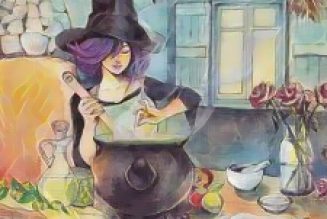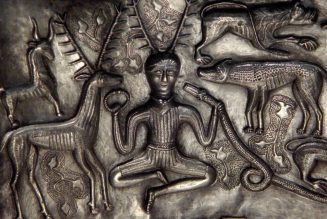The Witches Pentacle is a powerful symbol in Witchcraft, representing our connection to the Universe. The pentagram, a five-pointed star, is an ancient image found in both Eastern and Western philosophies. Even though it’s over 8,000 years old, its meaning is still relevant today. The pentagram reminds us that we can bring Spirit into our everyday lives, making us whole and balanced.
Picture a perfect, ripe apple. When you slice it in half, you’ll see a five-pointed star formed by the seeds inside. Each seed can symbolize something important: ideas, nourishment, life, secret knowledge, and the mysteries hidden within the earth. But why has this beautiful symbol—the pentagram—become so misunderstood and even feared in modern times?
In the story of Adam and Eve, the apple represented forbidden knowledge. While some ancient cultures encouraged the search for wisdom, others, especially in the West, reserved sacred knowledge for a single deity and discouraged people from seeking it. The apple, and by extension the pentagram, came to represent things we were told not to know. Over time, both the symbol and the pursuit of knowledge were suppressed.
For today’s Pagans, the Pentacle is rich with meaning. Its five points stand for the four directions—north, south, east, and west—with the fifth point representing Spirit. The circle around the star shows unity and wholeness. This symbol has been used for thousands of years, from ancient Babylonia to the Celts and Native American traditions. Because it’s drawn with a single, unbroken line, it’s often used to mark sacred spaces or for calling on deities and spirits.
The pentagram is one of the most important symbols for Neo-Pagans, including Wiccans and those who practice Ceremonial Magic. In rituals, Pagans might draw a pentagram in the air with a special blade called an athame, often in each of the four directions. A physical pentacle—a flat disc with the star—is a key tool on many altars. The symbol can also decorate magical tools like chalices, cauldrons, or the athame’s handle. For some, it represents feminine energy and is used to hold or bless objects like herbs, amulets, and crystals. Spells or chants are sometimes repeated five times for extra power, since numbers like 3, 5, 7, 9, and 13 are considered magical. Many Pagans wear the pentacle for protection and to show their connection to magic and wisdom.
Five-pointed shapes are rare in non-living things but common in living ones—like the human hand, starfish, and many flowers and plants. This pattern even appears at the molecular level. The number five, then, is deeply connected to life itself.
The pentagram has been a sacred symbol in many ancient cultures, including Egypt, India, Persia, and Greece. Almost every culture had a five-pointed symbol that was important to their spiritual life. In Celtic tradition, which influences much of modern Paganism, the number five appears everywhere: Ireland had five great roads, five provinces, and five paths of law. Even the fairy folk counted by fives, and legendary figures wore five-fold cloaks.
In the old Irish story “Cormac’s Cup of Gold,” the hero finds a fortress with four houses and a bright well, over which grow nine ancient hazel trees. Five salmon eat the nuts that fall from the trees, and the husks float down five streams. The well is called the Well of Knowledge, and the five streams represent the five senses—our ways of gaining knowledge. True wisdom comes from drinking from both the well and the streams.
Around 500 BCE, Pythagoras—a famous scholar and teacher—lived in Greece. He was known for his knowledge of math, music, government, and sacred geometry. Like the Celts and many modern Pagans, he believed in learning from both the physical and spiritual worlds.
Pythagoras started a school where people came to learn about divine knowledge. Sadly, the school was shut down for political reasons, and his followers had to go underground. For them, the five-pointed star became a secret sign—a way to recognize each other and their shared beliefs.
These secret schools continued, leading to the Gnostic and Hermetic Mystery Schools, which included both men and women and sometimes had Christian influences. The Masonic Guilds, skilled stone-masons who learned sacred geometry, also carried on these traditions. Even though the Church saw them as heretics, it still hired them to build Europe’s great cathedrals—many of which feature five-pointed designs. At the same time, medieval alchemists—scientists, philosophers, and magicians—studied the mysteries of the universe and kept the pentagram’s positive meaning alive.
This ancient wisdom survived underground through the Middle Ages and into modern times. But because this knowledge threatened the Church’s power, those who sought it—and the symbols they used—were often persecuted.
The pentagram, once a symbol of divine light, became associated with heresy and even evil. This negative image was made worse by some groups who used the upside-down pentagram for shock value, even though their beliefs were very different from most Pagans. Modern media often shows the pentagram as a symbol of evil, whether it’s upright or inverted, which adds to the misunderstanding.
Despite its troubled history, the pentagram has survived. Today, it’s still used by those who seek wisdom and spiritual connection. The sacred pentagram keeps its ancient, magical meanings and remains a symbol of life and divine knowledge.



























